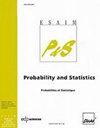连续体中种群扩展的随机测量值模型
IF 0.7
4区 数学
Q4 STATISTICS & PROBABILITY
引用次数: 3
摘要
我们通过两个具有选择的空间Λ-Fleming Viot过程(或SLFV)来建模空间扩展的种群:k-亲本SLFV和∞-亲本SLFV。为了做到这一点,我们用0型“幽灵”个体填充空白区域,这些个体与“真实”的1型个体相比具有很强的选择劣势,用参数k量化。幽灵个体的繁殖被解释为由于繁殖的随机性而导致的局部灭绝事件。当k→+∞时,对应于∞母SLFV的极限过程让人联想到渗透理论中的随机生长模型,但与研究群体样本遗传多样性的工具有关。本文给出了∞-父SLFV的一个严格构造,并证明了它对应于k-父SLFV在k→+∞时的极限。为了做到这一点,我们引入了k-亲本SLFV的另一种结构,它允许我们将具有不同选择强度的SLFV耦合起来,并且它本身就是我们感兴趣的。我们展示了∞-亲本SLFV的三种不同特征,它们在不同的环境下有效,并将群体遗传模型和随机生长模型联系在一起。本文章由计算机程序翻译,如有差异,请以英文原文为准。
Stochastic measure-valued models for populations expanding in a continuum
We model spatially expanding populations by means of two spatial Λ-Fleming Viot processes (or SLFVs) with selection: the k-parent SLFV and the ∞-parent SLFV. In order to do so, we fill empty areas with type 0 "ghost" individuals with a strong selective disadvantage against "real" type 1 individuals, quantified by a parameter k. The reproduction of ghost individuals is interpreted as local extinction events due to stochasticity in reproduction. When k → +∞, the limiting process, corresponding to the ∞-parent SLFV, is reminiscent of stochastic growth models from percolation theory, but is associated to tools making it possible to investigate the genetic diversity in a population sample. In this article, we provide a rigorous construction of the ∞-parent SLFV, and show that it corresponds to the limit of the k-parent SLFV when k → +∞. In order to do so, we introduce an alternative construction of the k-parent SLFV which allows us to couple SLFVs with different selection strengths and is of interest in its own right. We exhibit three different characterizations of the ∞-parent SLFV, which are valid in different settings and link together population genetics models and stochastic growth models.
求助全文
通过发布文献求助,成功后即可免费获取论文全文。
去求助
来源期刊

Esaim-Probability and Statistics
STATISTICS & PROBABILITY-
CiteScore
1.00
自引率
0.00%
发文量
14
审稿时长
>12 weeks
期刊介绍:
The journal publishes original research and survey papers in the area of Probability and Statistics. It covers theoretical and practical aspects, in any field of these domains.
Of particular interest are methodological developments with application in other scientific areas, for example Biology and Genetics, Information Theory, Finance, Bioinformatics, Random structures and Random graphs, Econometrics, Physics.
Long papers are very welcome.
Indeed, we intend to develop the journal in the direction of applications and to open it to various fields where random mathematical modelling is important. In particular we will call (survey) papers in these areas, in order to make the random community aware of important problems of both theoretical and practical interest. We all know that many recent fascinating developments in Probability and Statistics are coming from "the outside" and we think that ESAIM: P&S should be a good entry point for such exchanges. Of course this does not mean that the journal will be only devoted to practical aspects.
 求助内容:
求助内容: 应助结果提醒方式:
应助结果提醒方式:


